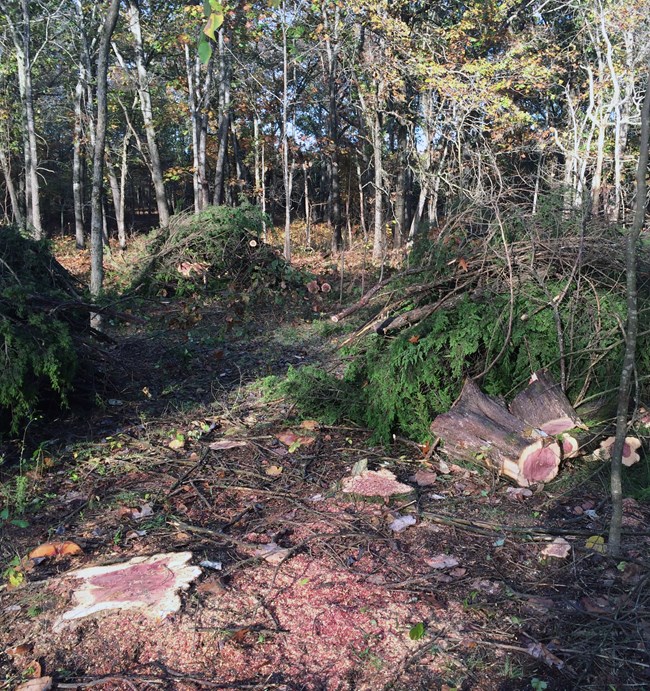Last updated: June 22, 2022
Article
Problematic Plant Monitoring at Pea Ridge National Military Park

NPS
What Are Problematic Plants?
Sometimes plants grow in places where they don't naturally occur and some plants can cause damage to ecosystems and even harm people. Exotic plants are nonnative species that are typically introduced into an ecosystem by human actions, whether intentional or not. Invasive plants are exotic species that cause ecological or economic harm. Pest plants, which can be native species, interfere with specific management objectives and are sometimes called weeds. We refer to the collection of exotic, invasive, and pest plants as problematic plants.
Problematic Plant Management
National parks spend a lot of time trying to remove or control problematic plants to protect native plant and animal communities and visitors at parks. When a plant species is impairing park resources, managers are required to control the plant. They use five criteria to decide what other problematic plants they will control: the origin of the species, prudence of the action, feasibility of controlling the plant, the harm or impact that the plant causes, and the harm that removal of the plant could cause. Environmental assessments, the professional judgment of experts, and scientific research provide the information managers need to make these decisions. Parks also consult with regulating agencies and the public.

NPS
Plant Surveys
Park managers need to know where problematic plants are to control them. The Heartland Inventory and Monitoring Network collects information on the cover (a measure of how much ground is covered by the plant), distribution, and location of problematic plants at Pea Ridge National Military Park. We surveyed the park in 2006, 2013, 2018, and 2021. Managers can develop management actions and track the success of their control efforts using the information from our surveys. We use an early detection watch list and a park-established watch list to search for problematic plants. Early detection species are plants that have not been detected on the park before but have the potential to grow there. Plants on the park-established watch list have been found in the park during previous surveys.
Problematic Plants at the Park
Since 2006, we have identified 38 problematic plants at Pea Ridge National Military Park; 35 of these species were present in 2021. Eight plant species exceeded the 10-acre threshold we use as an indicator of whether a plant species will be easy or difficult to control: winged sumac, black locust, Japanese honeysuckle, tall fescue, sericea lespedeza, multiflora rose, Japanese stiltgrass, and eastern redcedar. Because of the number, extent, and cover of problematic plants in the park, control efforts should focus on early detection treatments and strategic treatment of high priority species to protect features of the park's natural and cultural landscapes.
Survey Highlights
- Eastern redcedar has decreased with continued removal efforts.
- Japanese stiltgrass has rapidly increased parkwide; frequency of this species increased from 14% to 73% and cover increased from less than an acre to at least 105 acres between 2006 and 2021.
- Bigleaf periwinkle, crown vetch, Kentucky bluegrass, and sericea lespedeza also increased in 2021.
- Tree-of-heaven, silktree, princesstree, Callery pear, crown vetch, white mulberry, and spotted knapweed are all present in relatively low amounts; they may be good candidates for eradication.
| Scientific Name | Common Name |
|---|---|
| Ailanthus altissima | tree-of-heaven |
| Albizia julibrissin | silktree |
| Arctium minus* | lesser burdock* |
| Bromus inermis | smooth brome |
| Bromus racemosus | bald brome, spiked brome |
| Bromus sterilis | poverty brome |
| Carduus nutans | nodding plumeless thistle |
| Celastrus orbiculatus | Oriental bittersweet |
| Centaurea stoebe ssp. micranthos | spotted knapweed |
| Cirsium vulgare | bull thistle |
| Cynodon dactylon | Bermudagrass |
| Daucus carota | Queen Anne's lace |
| Euonymus fortunei | winter creeper |
| Glechoma hederacea | ground ivy |
| Hypericum perforatum* | common St. Johnswort* |
| Iris pseudacorus | paleyellow iris |
| Juniperus virginiana | eastern redcedar |
| Lespedeza cuneata | sericea lespedeza |
| Ligustrum sp. | privet sp. |
| Lonicera japonica | Japanese honeysuckle |
| Melilotus officinalis | yellow sweetclover |
| Microstegium vimineum | Nepalese browntop, Japanese stiltgrass |
| Morus alba | white mulberry |
| Paulownia tomentosa | princesstree |
| Poe compressa | Canada bluegrass |
| Poa pratensis | Kentucky bluegrass |
| Pyrus calleryana | Callery pear |
| Rhus copallinum | winged sumac |
| Rhus glabra* | smooth sumac* |
| Robinia pseudoacacia | black locust |
| Rosa multiflora | multiflora rose |
| Rumex crispus | curly dock |
| Schedonorus arundinaceus | tall fescue |
| Securigera varia | crownvetch |
| Sorghum halepense | Johnsongrass |
| Torilis arvensis | spreading hedgeparsley |
| Verbascum thapsus | common mullein |
| Vinca major | bigleaf periwinkle |

NPS
Species Spotlight: Eastern Redcedar
Eastern redcedar (Juniperus virginiana) is a native invasive plant species that is considered a noxious weed. It can rapidly take over a landscape and push out native plant communities. Wildfires keep this tree in check by preventing it from taking root but fire suppression over the years has allowed this tree to become problematic. Eastern redcedar is actually a juniper (in the cypress family) that grows anywhere from 10 to 35 feet tall. At Pea Ridge National Military Park, eastern redcedars are removed by manually cutting down the trees. This has decreased the number of redcedars on the park but our monitoring data show that an unfortunate side effect of removal may be the spread of sericea lespedeza (a non-native problematic plant) into the areas cleared of redcedar. We will continue to monitor these problematic plants to better understand how to manage them.
For More Information
Read the Full Report.Check back later for updates. We will update this page each year as we gather information.
Visit the Heartland Inventory & Monitoring Network website.






